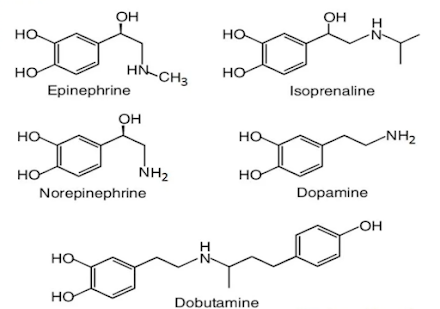The nervous system is a complicated network of nerves and cells that communicate information from the brain and spinal cord to different regions of the body.
The central nervous system is made up of the brain and spinal cord, whereas the peripheral nervous system is made up of the Somatic and Autonomic nervous systems.

Sympathomimetics are agents that stimulate adrenergic receptors. Sympatholytic medications work by inhibiting the activation of adrenergic receptors.



Intracellular response


They are all G-protein-coupled receptors. Adrenergic receptors come in two varieties.

Sympathomimetic drugs that replicate the activities of norepinephrine (NE) or epinephrine (EP) (Epi).
They are also known as sympathomimetic medicines, adrenomimetic drugs, adrenergic antagonists, and adrenoreceptor antagonists. Adrenergic Agonists / Sympathomimetic Drugs.




Structure required for activity
Terbutaline, for example.

The replacement of the meta hydroxyl of catechol promotes 2 selectivity and reduces COMT metabolism. Salbutamol as an example

The removal of the para hydroxyl group from epinephrine results in the production of a selective 1 agonist. Exp: - Phenylephrine

A small alkyl group (methyl or ethyl) present at carbon reduces MAO metabolism (Mono amine oxidase)

α/β receptor selectivity is determined by the type of the amino substituent. Activity at the -receptor decreases as the size of the alkyl group on nitrogen grows, whereas activity at the -receptor rises. Isoproterenol as an example.

Adrenergic action is high in primary and secondary amines.
SAR of Non – Catecholamine

Bridging unit
Typically, agonist action requires only a single methylene group or amino group.
Example -
X = CH2 (α1 agonist) - chlonidine
= NH (α2 agonist) - oxymetazoline
Imidazoline rings have a high level of agonist action.
Aromatic ring - When the aromatic ring is replaced with halogen or small alkyl groups, antagonist action increases (methyl).
The central nervous system is made up of the brain and spinal cord, whereas the peripheral nervous system is made up of the Somatic and Autonomic nervous systems.
Adrenergic Neurotransmitters
This occurs naturally in our bodies.Sympathomimetics are agents that stimulate adrenergic receptors. Sympatholytic medications work by inhibiting the activation of adrenergic receptors.
- Adrenergic neurotransmitters are classified into three types. Catecholamines are a class of substances that act together to give a sense of well-being. Noradrenaline (NA) - in postganglionic sympathetic sites (excluding sweat glands and hair follicles) and particular brain regions.
- Adrenaline (Adr) is a hormone released by the adrenal medulla.
- Dopamine (DA) is a neurotransmitter that may be found in the basal ganglia, limbic system, CTZ, and anterior pituitary gland.
Adrenergic Neurotransmitters
Intracellular response
Biosynthesis of Catecholamine
Metabolism of Neurotransmitter
- Catecholamines, both endogenous and exogenous, are primarily metabolized by two enzymes: monoamine oxidase and catechol-O-methyl transferase (COMT).
- MAO is found in cells linked to the surface membrane of mitochondria, which are prevalent in noradrenergic nerve terminals.
- COMT, a widely distributed enzyme found in both neuronal and nonneuronal tissues, operates on catecholamines and their deaminated derivatives generated by MAO activity.
- 3-methoxy-4-hydroxymandelic acid is the primary end metabolite of adrenaline and noradrenaline (VMA).
Catabolism of Catecholamine
They are all G-protein-coupled receptors. Adrenergic receptors come in two varieties.
Sympathomimetic drugs/ adrenergic agonist
Adrenergic medicines are chemicals that activate certain nerves in your body. They accomplish this by either imitating or increasing the release of the chemical messengers epinephrine and norepinephrine. These medications are used to treat a variety of life-threatening diseases, including cardiac arrest, shock, asthma attacks, and allergic reactions.Sympathomimetic drugs that replicate the activities of norepinephrine (NE) or epinephrine (EP) (Epi).
They are also known as sympathomimetic medicines, adrenomimetic drugs, adrenergic antagonists, and adrenoreceptor antagonists. Adrenergic Agonists / Sympathomimetic Drugs.
Classification of sympathomimetic drugs
Two types of classification can be applied to them -- Based on the mechanism of action
- Chemical classification
- Non – catecholamines
- Catecholamines
Catecholamines
This metabolite contains a catachol (3, 4-dihydroxybenzene ring). Other examples: nor-epinephrine, phenylephrine, dopamine, dobutamine, and isoproterenol.Non – Catecholamines
They do not have a catechol nucleus, are not inactivated by COMT, and have a long duration of action. Ex: Ephedrine, Phenylephrine, Terbutaline, Oxymetazoline, Pseudoephedrine, Clonidine, Amphetamine.Based on mechanism of action
Sympathomimetic drugs
- Mixed agents - Their actions can be direct or indirect.
- Direct acting agents - Indirectly or directly act as agonists on α & β.
- Indirect acting agents - N.A. is released from the adrenergic neuron
Structure required for activity
- Catechol or aromatic ring
- β - carbon hydroxy & amino terminal
- Phenyl Ethylamine as parent compound
- Phenyl ring substitution
- 3-hydroxy substitution is required for α - activity
- 4-hydroxy substitution is required for β – activity
- 3, 4 –dihydroxy substitution is required for both α & β - activity
Terbutaline, for example.
The replacement of the meta hydroxyl of catechol promotes 2 selectivity and reduces COMT metabolism. Salbutamol as an example
The removal of the para hydroxyl group from epinephrine results in the production of a selective 1 agonist. Exp: - Phenylephrine
A small alkyl group (methyl or ethyl) present at carbon reduces MAO metabolism (Mono amine oxidase)
- Activity is reduced when an ethyl group is present at carbon.
- The replacement of the OH (hydroxyl) group on the carbon is required for action.
α/β receptor selectivity is determined by the type of the amino substituent. Activity at the -receptor decreases as the size of the alkyl group on nitrogen grows, whereas activity at the -receptor rises. Isoproterenol as an example.
Adrenergic action is high in primary and secondary amines.
SAR of Non – Catecholamine
Bridging unit
Typically, agonist action requires only a single methylene group or amino group.
Example -
X = CH2 (α1 agonist) - chlonidine
= NH (α2 agonist) - oxymetazoline
Imidazoline rings have a high level of agonist action.
Aromatic ring - When the aromatic ring is replaced with halogen or small alkyl groups, antagonist action increases (methyl).
Get subject wise printable pdf notesView Here


No comments:
Post a Comment
Please don't spam. Comments having links would not be published.